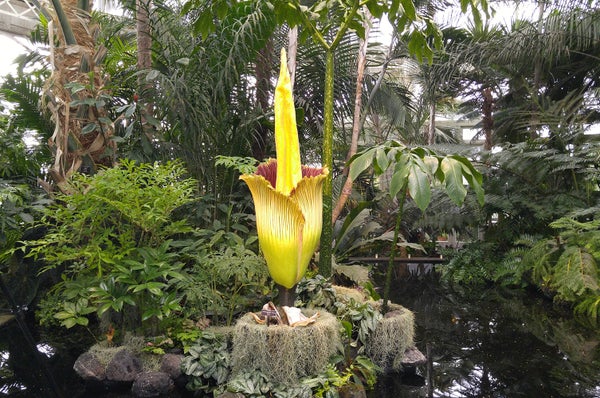One of the greenhouses at the New York Botanical Garden currently reeks. The culprit is a corpse flower—a plant that blooms as rarely as once a decade and maintains its flower for only about 36 hours. The New York Botantical Garden hasn’t had a corpse flower since 1939. This particular 1.9-meter specimen has been 10 years in the making.
What exactly does it smell like? “Like if you cook cabbage and steam it, and then you leave it overnight,” says Lameta Nolan, a vistor to the special event.
“It smells like a sewer,” says Margo Boy, another brave viewer. “Like New York garbage.”
On supporting science journalism
If you're enjoying this article, consider supporting our award-winning journalism by subscribing. By purchasing a subscription you are helping to ensure the future of impactful stories about the discoveries and ideas shaping our world today.
Amorphophallus titanum—which roughly translates to “giant misshapen phallus”—mimics decomposing flesh in order to attract pollinators, says Marc Hachadourian, the director of the Nolen Greenhouses, where the plant resides. “The plant not only looks like rotting meat—in terms of the color of the flower—it smells like it, too. It actually contains some of the same compounds that are present in putrefied flesh and fish. Chemically, it’s almost identical to these terrible smells,” he explains. In fact, the flower produces dimethyl trisulfide (also found in Limburger cheese and cabbage), trimethylamine (normally released by rotting fish and animals), isovaleric acid (a major component of foot odor) and indole (found in human feces).
As ofnoon on Friday the corpse flower was open but its scent was not yet at full potency. As expected, flies were buzzing lazily into and out of the enormous bloom—attracted for the same reasons as the native pollinators, carrion beetles and flesh flies. The flower is quite striking to look at, with a huge potatolike pod, called the spadix, rising out of a frilly and fantastically colored spath, which resembles a petal. “It always creates a sensation wherever this plant blooms,” Hachadourian says. This time was no exception; long lines stretched out of the greenhouse.
